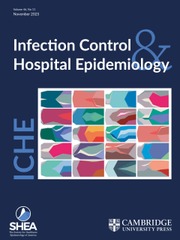Crossref Citations
This article has been cited by the following publications. This list is generated based on data provided by Crossref.
von Reyn, C.F
Marlow, J.N
Arbeit, R.D
Barber, T.W
and
Falkinham, J.O
1994.
Persistent colonisation of potable water as a source of Mycobacterium avium infection in AIDS.
The Lancet,
Vol. 343,
Issue. 8906,
p.
1137.
Levin, A.S.S.
Gobara, S.
Scarpitta, C.M.
Warschauer, C.L.
Sinto, S.I.
Rodrigues, E.
Mendes, C.M.F.
Sabbaga, E.
and
Boulos, M.
1995.
Electric showers as a control measure for Legionella spp. in a renal transplant unit in São Paulo, Brazil.
Journal of Hospital Infection,
Vol. 30,
Issue. 2,
p.
133.
Goetz, Angella
and
Yu, Victor L.
1997.
Copper-silver ionization: Cautious optimism for Legionella disinfection and implications for environmental culturing.
American Journal of Infection Control,
Vol. 25,
Issue. 6,
p.
449.
Bannan, Jason D.
1997.
Legionellosis.
Antimicrobics and Infectious Diseases Newsletter,
Vol. 16,
Issue. 10,
p.
73.
Fridkin, Scott K.
Welbel, Sharon F.
and
Weinstein, Robert A.
1997.
MAGNITUDE AND PREVENTION OF NOSOCOMIAL INFECTIONS IN THE INTENSIVE CARE UNIT.
Infectious Disease Clinics of North America,
Vol. 11,
Issue. 2,
p.
479.
Stout, Janet E.
and
Yu, Victor L.
1997.
Legionellosis.
New England Journal of Medicine,
Vol. 337,
Issue. 10,
p.
682.
Dieckhaus, Kevin D.
and
Cooper, Brian W.
1998.
INFECTION CONTROL CONCEPTS IN CRITICAL CARE.
Critical Care Clinics,
Vol. 14,
Issue. 1,
p.
55.
Lin, Yu‐sen E.
Vidic, Radisav D.
Stout, Janet E.
and
Yu, Victor L.
1998.
Legionella in water distribution systems.
Journal AWWA,
Vol. 90,
Issue. 9,
p.
112.
Harvey, Maurene A.
1998.
Critical-Care–Unit Bedside Design and Furnishing: Impact on Nosocomial Infections.
Infection Control & Hospital Epidemiology,
Vol. 19,
Issue. 8,
p.
597.
Bartley, Judene Mueller
2000.
APIC State-of-the-Art Report: The role of infection control during construction in health care facilities.
American Journal of Infection Control,
Vol. 28,
Issue. 2,
p.
156.
Bartley, Judene Mueller
2000.
APIC State-of-the-Art Report: The role of infection control during construction in health care facilities.
American Journal of Infection Control,
Vol. 28,
Issue. 2,
p.
156.
Berthelot, P
Grattard, F
Turco, M
Ros, A
Troy, P
Lucht, F
and
Pozzetto, B
2001.
Stratégie de prévention du risque de légionellose nosocomiale à l'hôpital Nord, CHU De Saint-Etienne.
Médecine et Maladies Infectieuses,
Vol. 31,
Issue. 2,
p.
91.
Lundstrom, Tammy
Pugliese, Gina
Bartley, Judene
Cox, Jack
and
Guither, Carol
2002.
Organizational and environmental factors that affect worker health and safety and patient outcomes.
American Journal of Infection Control,
Vol. 30,
Issue. 2,
p.
93.
Salvatorelli, G.
Medici, S.
Finzi, G.
De Lorenzi, S.
and
Quarti, C.
2005.
Effectiveness of installing an antibacterial filter at water taps to prevent Legionella infections.
Journal of Hospital Infection,
Vol. 61,
Issue. 3,
p.
270.
Ragull, Sonia
Pedro-Botet, María Luisa
García-Núñez, Marian
Esteve, María
Sopena, Nieves
Rey Joly, Celestino
and
Sabrià, Miquel
2006.
Choque térmico como medida de control de un brote de legionelosis hospitalaria.
Medicina Clínica,
Vol. 127,
Issue. 6,
p.
211.
Oliveira, M.S.
Maximino, F.R.
Lobo, R.D.
Gobara, S.
Sinto, S.I.
Ianhez, L.E.
Warschauer, C.L.
and
Levin, A.S.S.
2007.
Disconnecting central hot water and using electric showers to avoid colonization of the water system by Legionella pneumophila: an 11-year study.
Journal of Hospital Infection,
Vol. 66,
Issue. 4,
p.
327.
Dembry, Louise‐Marie
and
Torres‐Viera, Carlos
2011.
Molecular Techniques for the Study of Hospital‐Acquired Infection.
p.
39.
Unger, C.
and
Lück, C.
2012.
Inhibitory effects of silver ions on Legionella pneumophila grown on agar, intracellular in Acanthamoeba castellanii and in artificial biofilms.
Journal of Applied Microbiology,
Vol. 112,
Issue. 6,
p.
1212.

